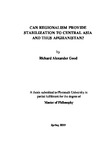CAN REGIONALISM PROVIDE STABILIZATION TO CENTRAL ASIA AND THUS AFGHANISTAN?
| dc.contributor.supervisor | Moustakis, Fotios | |
| dc.contributor.author | Good, Richard | |
| dc.contributor.other | Faculty of Arts, Humanities and Business | en_US |
| dc.date.accessioned | 2019-07-02T11:48:20Z | |
| dc.date.issued | 2019 | |
| dc.identifier | 10292201 | en_US |
| dc.identifier.uri | http://hdl.handle.net/10026.1/14542 | |
| dc.description.abstract |
This research was undertaken as there is a gap in the current academic realm, in which Central Asia and Afghanistan were heavily referenced, but none which went a step further and critically analyzed a new regionalism which would tie Afghanistan and Central Asia together bilaterally and multilaterally, whilst also deciphering through analysis, theory, and practice, the most suitable type of regionalism to be employed to achieve stability in Central Asia and thus Afghanistan. There is much discussion on regionalism as a standalone product and theory, and little on the formulation of a new regional body, one which can provide the framework for a unique type of forum which is necessary for Central Asia. Inclusiveness, openness, non-judgmentalism, and building links through trade, security, and development across the board where the main issues to be researched in order to find a more perfect union for the region, one which could offer hope, change, and a radical departure from the failed techniques of the status quo, following the ASEAN method. The methodology employed in the research included the case study method and historical analysis. These forms of research in themselves provide a solid foundation to answer the research questions in order to formulate the most likely form of regionalism needed to be employed to accomplish stability in Central Asia, including proposing the radical notion of strong man politics or illiberal regionalism. The results were that cooperation on many levels from the grassroots up to the highest echelons of government were necessary for cooperation between Central Asian states. Key areas of common concern were identified, and cooperation based upon these has the probability to spur further cooperation and integration needed to work towards a regionalist model with the goal of stabilizing and growing prosperity and development in Central Asia and Afghanistan, the implications of which are self-evident and self-proving. | en_US |
| dc.language.iso | en | |
| dc.publisher | University of Plymouth | |
| dc.rights | CC0 1.0 Universal | * |
| dc.rights.uri | http://creativecommons.org/publicdomain/zero/1.0/ | * |
| dc.subject.classification | MPhil | en_US |
| dc.title | CAN REGIONALISM PROVIDE STABILIZATION TO CENTRAL ASIA AND THUS AFGHANISTAN? | en_US |
| dc.type | Thesis | |
| plymouth.version | publishable | en_US |
| dc.identifier.doi | http://dx.doi.org/10.24382/461 | |
| dc.rights.embargodate | 2020-01-02T11:48:20Z | |
| dc.rights.embargoperiod | 6 months | en_US |
| dc.type.qualification | Masters | en_US |
| rioxxterms.version | NA |
Files in this item
This item appears in the following Collection(s)
-
01 Research Theses Main Collection
Research Theses Main



